
USS Chickasaw was the last in line of the four monitors that covered Rear Admiral Farragut's fleet as it passed Fort Morgan during the Battle of Mobile Bay, and was the only one whose performance that day was not flawed by tragedy or mechanical breakdowns. After passing the fort, she played a leading role in the capture of CSS Tennessee. When the Confederate ironclad came up the bay to attack the Union ships, Chickasaw placed herself across the slow-moving enemy's stern. Skillfully using her four propellers to crab along sideways, the monitor was able to maintain a rapid and relentless fire against the rear of Tennessee's iron-armored casemate, preventing her from using her guns to fire aft, probably cutting her steering chains, and so weakening the casemate that it was brought to the verge of collapse. More than any other factor, this punishment at the hands of Chickasaw's four eleven-inch Dahlgren smoothbore guns led to the surrender of the Confederate warship.
This page features all our views of USS Chickasaw during
the Battle of Mobile Bay, 5 August 1864.
For other images of USS Chickasaw, see:
| If you want higher resolution reproductions than the digital images presented here, see: "How to Obtain Photographic Reproductions." |
Click on the small photograph to prompt a larger view of the same image.
|
Photo #: NH 42392 "Battle of Mobile Bay, August 5, 1864" Reproduction of an 1864 pen & ink drawing by George S. Waterman, C.S.N., depicting the action as seen from above and inside the entrance to Mobile Bay. Confederate ships present are (as identified on the drawing): Selma, Morgan, Gaines (shown twice, in the battle line, and beached off Fort Morgan after the battle) and Tennessee. Union monitors shown are (from the front of the line): Tecumseh (sinking after striking a mine), Manhattan, Winnebago and Chickasaw. The leading two steam sloops in the Union line are Brooklyn and Hartford. Small diagram in the lower right represents the various efforts by Union ships to ram the Tennessee later in the action. U.S. Naval Historical Center Photograph. Online Image: 150KB; 740 x 580 pixels |
 |
|
Photo #: NH 2377 Battle of Mobile Bay, 5 August 1864 USS Monongahela rams CSS Tennessee as other Union warships move into position to engage. The two twin-turret monitors depicted at the right are USS Winnebago and USS Chickasaw. Civil War vintage artwork, photographed by T. Lilienthal, New Orleans, Louisiana. Courtesy of the Philibrick Collection, Kittery, Maine. U.S. Naval Historical Center Photograph. Online Image: 77KB; 740 x 495 pixels |
 |
|
Photo #: NH 1055 "The 'Tennessee' at Bay, in the Battle of Mobile Bay", 5 August 1864 Halftone reproduction of a Currier & Ives lithograph, published in "Admiral Franklin Buchanan, Fearless Man of Action", by Charles Lee Lewis. The original lithograph was provided by Mr. Franklin Buchanan Owen. Another copy is reportedly held by the Library of Congress. This view depicts, none too accurately, the CSS Tennessee in the center at the time she surrendered, surrounded by the Union warships. The latter include (at right) the twin-turret monitors Chickasaw and Winnebago at right. One of the single-turret monitors would be Manhattan. There was no second single-turret monitor present at this stage of the battle. The large ship in the left foreground is presumably USS Hartford. Fort Morgan is shown in the right distance, but much closer to the action than was actually the case. U.S. Naval Historical Center Photograph. Online Image: 99KB; 740 x 405 pixels |
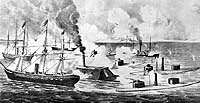 |
|
Photo #: NH 1678 Battle of Mobile Bay, 5 August 1864 CSS Tennessee surrounded by Union warships, near the end of the battle. The two twin-turret monitors depicted off her bow and stern are USS Winnebago and USS Chickasaw. Civil War vintage artwork, photographed by T. Lilienthal, New Orleans, Louisiana. Courtesy of the Philibrick Collection, Kittery, Maine. U.S. Naval Historical Center Photograph. Online Image: 97KB; 740 x 515 pixels |
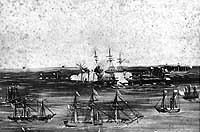 |
|
Photo #: NH 42395 "Surrender of Ram Tennessee" Photograph of a sketch by 3rd Assistant Engineer Robert Weir, of USS Richmond. It depicts the CSS Tennessee surrounded by U.S. Navy warships at the conclusion of the Battle of Mobile Bay, 5 August 1864. Ship in the left foreground is USS Hartford. Twin-turret monitors at right are USS Chickasaw and USS Winnebago. U.S. Naval Historical Center Photograph. Online Image: 79KB; 740 x 320 pixels |
 |
|
Photo #: KN-843 (Color) Battle of Mobile Bay, 5 August 1864 Oil on canvas (40" x 66") by Xanthus Smith (1839-1929), signed and dated by the artist, 1890. It depicts the surrender of CSS Tennessee to the Union squadron commanded by Rear Admiral David G. Farragut. Identifiable U.S. Navy ships present include: Winnebago (monitor in the left distance), Chickasaw (monitor in the foreground) and Hartford (Farragut's flagship, in the right center, painted light gray). Courtesy of the U.S. Naval Academy Museum, Annapolis, Maryland. Gift of Henry Huddleston Rogers, 1930. Official U.S. Navy Photograph. Online Image: 67KB; 740 x 470 pixels Reproductions of this image may also be available through the National Archives photographic reproduction system as Photo # 428-KN-843 |
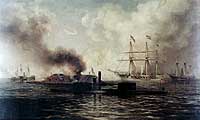 |
|
Photo #: NH 1276 Battle of Mobile Bay, 5 August 1864 Line engraving after an artwork by J.O. Davidson, published in "Battles and Leaders of the Civil War", Volume 4, page 378. Entitled "Surrender of the 'Tennessee,' Battle of Mobile Bay", it depicts CSS Tennessee in the center foreground, surrounded by the Union warships (from left to right): Lackawanna, Winnebago, Ossipee, Brooklyn, Itasca, Richmond, Hartford and Chickasaw. Fort Morgan is shown in the right distance. U.S. Naval Historical Center Photograph. Online Image: 179KB; 740 x 540 pixels |
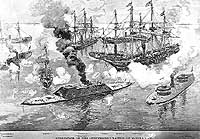 |
|
Photo #: NH 42394 "Capture of the Confederate ram Tennessee" Artwork by J.O. Davidson, depicting the surrender of CSS Tennessee at the conclusion of the Battle of Mobile Bay, 5 August 1864. U.S. Navy ships depicted include monitor Winnebago and sloop Monongahela, in the left background; sloop Ossipee "in collision with Tennessee", in center; monitor Chickasaw "lying across the stern of Tennessee", in right foreground; gunboat Itaska, in right distance; and flagship Hartford further to the right. U.S. Naval Historical Center Photograph. Online Image: 85KB; 740 x 410 pixels |
 |
|
Photo #: NH 42393 Battle of Mobile Bay, August 5, 1864 Photograph of sketches by 3rd Assistant Engineer Robert Weir, of USS Richmond, that were presented by him to Captain Thornton Jenkins. The top sketch depicts the Union steam sloops Richmond, Hartford and Brooklyn on "The Day before the Battle Aug. 4th ...". Sketch plan at bottom depicts the Union "Fleet Anchored" within Mobile Bay after passing Fort Morgan. Ships represented include Hartford, Brooklyn and Richmond plus the monitors Chickasaw and Winnebago. U.S. Naval Historical Center Photograph. Online Image: 94KB; 740 x 505 pixels |
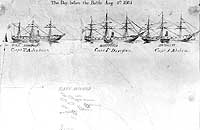 |
|
Photo #: NH 83136 "Entrance of Rear Admiral Farragut in to Mobile Bay. August 5th 1864" Chart of the action, prepared by RAdm. D.G. Farragut, Washington, D.C., March 1st, 1865. See Photo # NH 83136 (complete caption) for further information, as printed on the original chart. Courtesy of the Naval Historical Foundation. U.S. Naval Historical Center Photograph. Online Image: 277KB; 870 x 1200 pixels |
 |
For other images of USS Chickasaw, see:
| If you want higher resolution reproductions than the digital images presented here, see: "How to Obtain Photographic Reproductions." |
New images added 16 September 2000